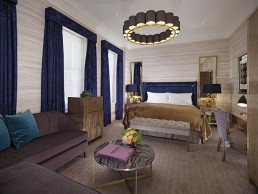
Flemings Mayfair, UK
Having worked in various architectural practices after graduating in Interior Design at university, Bronwen Tully and Tony Filmer set up interior design practice Tully Filmer in 1993 and have since worked on numerous restaurants, hotels and private houses in London and abroad. Following a project in partnership with Stanton Williams Architects on a modern London house and completing the restoration and interior design of Masseria Petraolo, a fourteen bedroom, fortified farm house in Southern Italy, the practice was approached by Henrik Muehle – the newly appointed General Manager of the Flemings Mayfair hotel in London, which first opened in 1851 – to help with its interior redesign.
Muehle, who was charged with upgrading the Flemings to a five star hotel, saw to it that part of this upgrade included a extensive remodelling and refurbishment of the hotel bedrooms and restaurant. The initial brief was to improve the quality of the fixtures and fittings with a coherent, sophisticated design suitable for the Georgian hotel.
Working within the brief, Tully Filmer’s initial design concept used classical modern design with strong signature colours, together with plush upholstered furniture and a suite of bespoke joinery furniture. With this in mind, the practice selected British lighting manufacturer Martin Huxford Studio to supply its Bibendum chandeliers and wall lights, to feature in all rooms and suites of the famous boutique hotel.
Hanging throughout the bedrooms and suites as a centrepiece, the Bibendum’s mixture of classical and modernist references, featuring hand-brushed horizontal gold rings that encircle multiple charcoal grey shades, suited the hotel’s classic interior. Alongside the chandeliers, the Bibendum wall sconce was also used to bring extra warmth.
The starting point for the project was selecting three strong colours. From this, the practice looked at fabric which had a modern interpretation of 1930’s elegance and from that, the furniture was designed and fittings chosen. The importance of the lighting wasn’t underestimated, especially in the hotel’s bedrooms and bathrooms where guests need to feel comfortable and at home.
Bronwen Tully explained: “It was important for us to have a mixture of LED and incandescent lamps to create comfortable lighting levels suitable for the bedroom and bathroom, most of which were on dimmers so that a variety of moods could be created to suit the time of day and guests using the room. A mixture of light sources has always been important in our schemes: task – in the form of bedside reading lights, desk lights, backlit mirrors and illuminated magnifying mirrors; occasional – in the form of standard lamps and bedside table lights; ambient – in the form of dimmable down lighters and decorative in the form of the chandelier.”
Visually, the decorative lighting brings the scheme together and gives a more luxurious, homely feel to the personal space of the rooms. It was very important to the designers to get the right balance of different fixtures to enhance the design while practically providing the correct type of lighting. This included using Porta Romana wall bedside lights, Chelsom built-in bed reading lights, Gubi desk lights and Bestlight floorlights in the hotel’s bedrooms. Additionally, a Porta Romana chandelier was used in the lobby of one of the hotel’s suites.
The resulting interior is very much in tune with Tully Filmer’s signature style: very much classic with a touch of modern, sumptuous fabrics, attention to detail and beautiful pieces of furniture. With the Martin Huxford chandeliers such a focal point in the hotel, Tully explained their reasoning for working with the manufacturer: “The Bibendum chandelier reflected our slight 1930’s style but in a modern way suiting our design perfectly. The generous mass of the fitting is shallow and wide, working well with our high ceilings and simple ceiling mouldings. The gold of the chandelier added a hint of glamour to our interior of textural greys and palette of signature colours – indigo, mustard and teal. It’s mass is akin to a UFO hovering just below the ceiling, making one aware of the generous high ceilings.”
When asked if the practice could go back and do the project again and would it do anything differently? Tully answered: “Design wise probably not – we would have liked to have used real shagreen on the desk but it would have been impractical for a hotel.”



